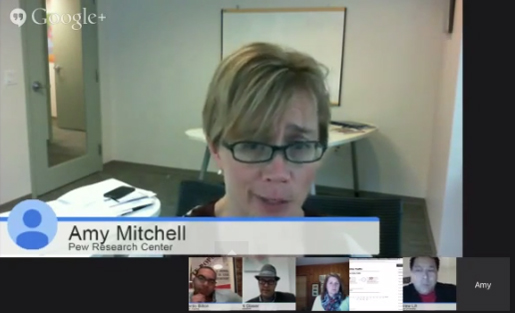Our news consumption is becoming increasingly mobile according to Pew’s annual State of The News Media report. Americans are now turning to their phones and tablets to catch up on the news. More people are visiting news sites like the New York Times on mobile than on their desktops. More than 75 percent of the Top 50 news sites in the U.S. received higher traffic from mobile devices than from desktops. As you might expect, the trend is the same for news organizations born on the web. But Pew found that being digitally native doesn’t necessarily translate to more mobile traffic. Meanwhile, advertising on the mobile web jumped 78 percent from the previous year while digital advertising grew as a whole. That’s good news for Facebook which owns the single largest share of both mobile and digital ad revenues. Mobile technology also helped podcasts achieve “a milestone moment” in 2014 with the success of “Serial.” Mobile devices account for nearly two-thirds of podcast downloads. The number of Americans that listen to podcasts has doubled since 2008, the study shows. And a third of all Americans listen to at least one podcast. We’ll take apart these findings with Amy Mitchell, director of journalism research at Pew Research Center; Ricardo Bilton, Digiday staff writer; Kerri Hoffman, PRX chief operations officer; and regular Andrew Lih, at American University. PBS MediaShift’s Mark Glaser will host and Jefferson Yen will be producing.
Don’t have a lot of time to spare but still want to listen to the Mediatwits? Then check out our Digital Media Brief below!
Mediatwits: Full Episode
Digital Media Brief
Listen to the Mediatwits and follow us on SoundCloud! Thanks to SoundCloud for providing audio support. Subscribe to the Mediatwits audio version via iTunes. Follow @TheMediatwits on Twitter. Subscribe to our YouTube Channel.
MEDIATWITS BIOS
 Mark Glaser is executive editor of MediaShift and Idea Lab. He is a longtime freelance writer and editor, who has contributed to magazines such as Entertainment Weekly, Wired and Conde Nast Traveler, and websites such as CNET and the Yale Global Forum. He lives in San Francisco with his wife Renee and son Julian. You can follow him on Twitter @mediatwit.
Mark Glaser is executive editor of MediaShift and Idea Lab. He is a longtime freelance writer and editor, who has contributed to magazines such as Entertainment Weekly, Wired and Conde Nast Traveler, and websites such as CNET and the Yale Global Forum. He lives in San Francisco with his wife Renee and son Julian. You can follow him on Twitter @mediatwit.
 Andrew Lih is a new media journalist and associate professor of journalism at the American University School of Communication. He is the author of “The Wikipedia Revolution” (Hyperion 2009, Aurum UK 2009) and is a noted expert on online collaboration and journalism. He is a veteran of AT&T Bell Laboratories and in 1994 created the first online city guide for New York City (www.ny.com). Follow him on Twitter @fuzheado.
Andrew Lih is a new media journalist and associate professor of journalism at the American University School of Communication. He is the author of “The Wikipedia Revolution” (Hyperion 2009, Aurum UK 2009) and is a noted expert on online collaboration and journalism. He is a veteran of AT&T Bell Laboratories and in 1994 created the first online city guide for New York City (www.ny.com). Follow him on Twitter @fuzheado.
SPECIAL GUESTS
Amy Mitchell is director of journalism research for the Pew Research Center. She is responsible for the center’s research related to news and information, including the annual State of the News Media report. Prior to joining Pew Research Center, Mitchell was a congressional research associate at the American Enterprise Institute, where she researched public policy and the relationship of the press, the public, and government. Follow her @asmitch

Ricardo Bilton is a reporter for Digiday, where he covers how the Web is changing how media companies build and make money off audiences. He tweets @rbilton
 Kerri Hoffman is Chief Operating Officer of PRX, the award-winning public media company whose mission is to harness technology to bring significant stories to millions of people. She tweets @kerriprx
Kerri Hoffman is Chief Operating Officer of PRX, the award-winning public media company whose mission is to harness technology to bring significant stories to millions of people. She tweets @kerriprx
BACKGROUND
While mobile technology is ascendant that’s not to say other platforms are dead. For all the focus on digital, 56% of newspaper readers only read them in print. But that’s a dwindling population, and worse, newspaper publishers have been seeing their share of advertising revenue decline in addition to a fall in subscriptions. In 2005, newspapers made $47 billion in revenue from print ads. Last year, they made $16 billion. Advertisers are now sending that money to Internet giants. Facebook, Google, AOL, and Twitter own just more than 50 percent of the revenue from display ads.
Radio, it seems, is starting to undergo the digital revolution that print papers went through. More than half of all Americans have listened to online radio in the past month with 73 percent listening via smartphone. The survey also revealed more people are listening to online radio in their cars. Reflecting this change, digital ad revenue for radio increased 9 percent from the last year.
Is the move toward mobile going to continue or ever slow down? What does this mean for legacy and digital-native publishers? And will the rise in podcasting mean sustained business models for all the new shows and networks?
Jefferson Yen is the producer for the Mediatwits Podcast. His work has been on KPCC Southern California Public Radio and KRTS Marfa Public Radio. You can follow him @jeffersontyen.


